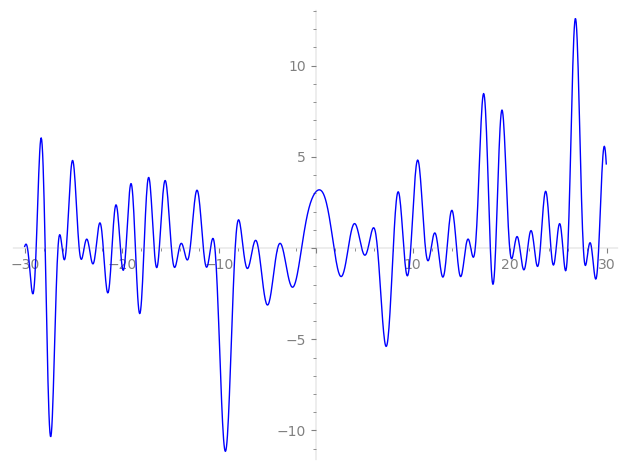| L(s) = 1 | + (1.98 + 0.209i)2-s − 1.73i·3-s + (3.91 + 0.833i)4-s + 4.86i·5-s + (0.362 − 3.44i)6-s − 11.9i·7-s + (7.60 + 2.47i)8-s − 2.99·9-s + (−1.01 + 9.66i)10-s + (1.44 − 10.9i)11-s + (1.44 − 6.77i)12-s + 20.4·13-s + (2.50 − 23.8i)14-s + 8.41·15-s + (14.6 + 6.52i)16-s + 26.3i·17-s + ⋯ |
| L(s) = 1 | + (0.994 + 0.104i)2-s − 0.577i·3-s + (0.978 + 0.208i)4-s + 0.972i·5-s + (0.0604 − 0.574i)6-s − 1.71i·7-s + (0.950 + 0.309i)8-s − 0.333·9-s + (−0.101 + 0.966i)10-s + (0.130 − 0.991i)11-s + (0.120 − 0.564i)12-s + 1.57·13-s + (0.179 − 1.70i)14-s + 0.561·15-s + (0.913 + 0.407i)16-s + 1.54i·17-s + ⋯ |
\[\begin{aligned}\Lambda(s)=\mathstrut & 264 ^{s/2} \, \Gamma_{\C}(s) \, L(s)\cr =\mathstrut & (0.902 + 0.431i)\, \overline{\Lambda}(3-s) \end{aligned}\]
\[\begin{aligned}\Lambda(s)=\mathstrut & 264 ^{s/2} \, \Gamma_{\C}(s+1) \, L(s)\cr =\mathstrut & (0.902 + 0.431i)\, \overline{\Lambda}(1-s) \end{aligned}\]
Particular Values
| \(L(\frac{3}{2})\) |
\(\approx\) |
\(2.99857 - 0.680205i\) |
| \(L(\frac12)\) |
\(\approx\) |
\(2.99857 - 0.680205i\) |
| \(L(2)\) |
|
not available |
| \(L(1)\) |
|
not available |
\(L(s) = \displaystyle \prod_{p} F_p(p^{-s})^{-1} \)
| $p$ | $F_p(T)$ |
|---|
| bad | 2 | \( 1 + (-1.98 - 0.209i)T \) |
| 3 | \( 1 + 1.73iT \) |
| 11 | \( 1 + (-1.44 + 10.9i)T \) |
| good | 5 | \( 1 - 4.86iT - 25T^{2} \) |
| 7 | \( 1 + 11.9iT - 49T^{2} \) |
| 13 | \( 1 - 20.4T + 169T^{2} \) |
| 17 | \( 1 - 26.3iT - 289T^{2} \) |
| 19 | \( 1 - 12.5T + 361T^{2} \) |
| 23 | \( 1 + 35.3T + 529T^{2} \) |
| 29 | \( 1 + 13.2T + 841T^{2} \) |
| 31 | \( 1 + 19.6T + 961T^{2} \) |
| 37 | \( 1 + 9.27iT - 1.36e3T^{2} \) |
| 41 | \( 1 + 13.7iT - 1.68e3T^{2} \) |
| 43 | \( 1 + 23.0T + 1.84e3T^{2} \) |
| 47 | \( 1 + 63.7T + 2.20e3T^{2} \) |
| 53 | \( 1 - 21.7iT - 2.80e3T^{2} \) |
| 59 | \( 1 - 66.8iT - 3.48e3T^{2} \) |
| 61 | \( 1 + 50.9T + 3.72e3T^{2} \) |
| 67 | \( 1 - 87.6iT - 4.48e3T^{2} \) |
| 71 | \( 1 - 13.1T + 5.04e3T^{2} \) |
| 73 | \( 1 + 47.7iT - 5.32e3T^{2} \) |
| 79 | \( 1 - 39.2iT - 6.24e3T^{2} \) |
| 83 | \( 1 - 60.8T + 6.88e3T^{2} \) |
| 89 | \( 1 - 25.2T + 7.92e3T^{2} \) |
| 97 | \( 1 - 107.T + 9.40e3T^{2} \) |
| show more | |
| show less | |
\(L(s) = \displaystyle\prod_p \ \prod_{j=1}^{2} (1 - \alpha_{j,p}\, p^{-s})^{-1}\)
Imaginary part of the first few zeros on the critical line
−11.58281341257186310622701524983, −10.84330068682814946517711559142, −10.39398029488445109337822291742, −8.301996141437233812941547075961, −7.47972628505848687467822195415, −6.49427193496033477488552381252, −5.91591267823991532025541611652, −3.92294279163346187479340503505, −3.41655430206515744042203182545, −1.45633814889725968994228600975,
1.88788375720237814857654522709, 3.35236740932827319759347145487, 4.73816947986262970774898893620, 5.39271955833466699118386179151, 6.36364475123699846877665186356, 7.993923609737516896970276689449, 9.077677244397750077877739449503, 9.795744808659072658714714674721, 11.30941099406985816547219492645, 11.89751428264807424555237427539

